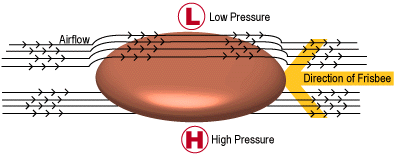
Unlike an (typical) airfoil, a frisbee has gyroscopic rotation. This serves to provide stability for the travelling frisbee, which would otherwise wobble in the air and fall to the ground.
Another researcher is using wind tunnel tests on a flying disc model to understand the aerodynamics of a frisbee. The goal? To develop an Unmanned Air Vehicle (UAV) based on a spin-stabilized axi-symmetric flying disc:

